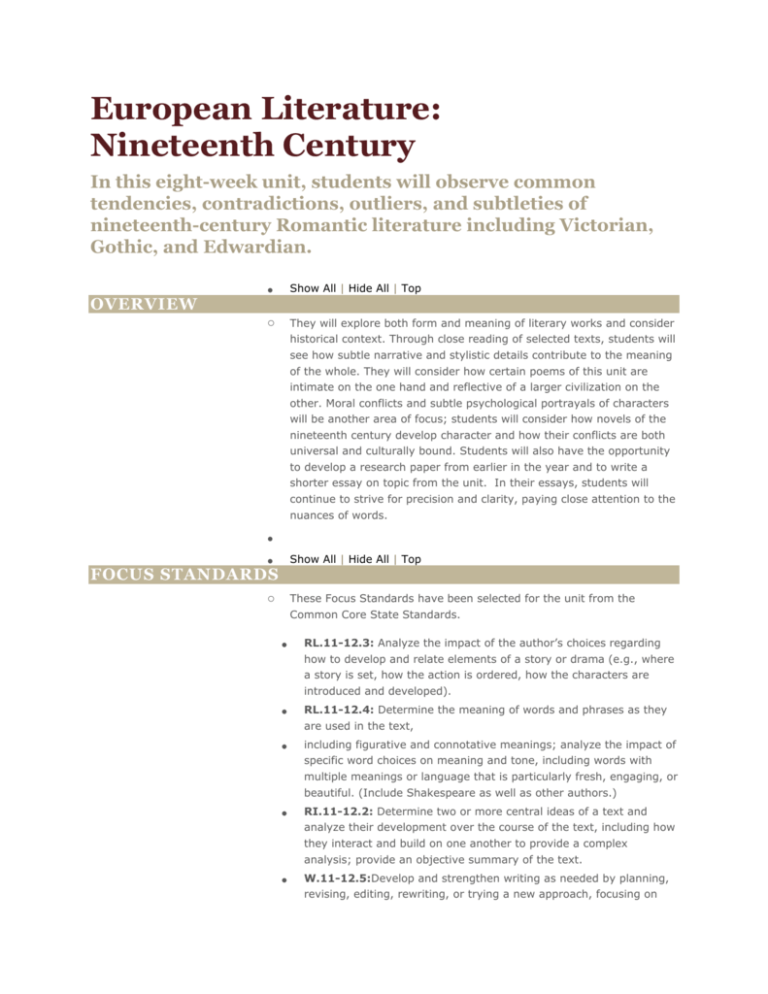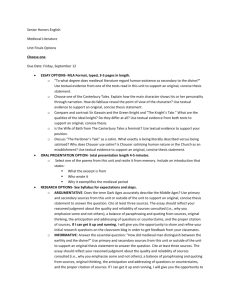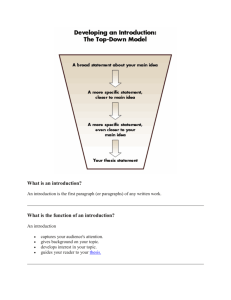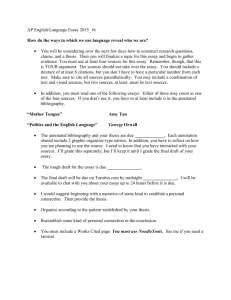European Literatur5
advertisement

European Literature: Nineteenth Century In this eight-week unit, students will observe common tendencies, contradictions, outliers, and subtleties of nineteenth-century Romantic literature including Victorian, Gothic, and Edwardian. OVERVIEW Show All | Hide All | Top o They will explore both form and meaning of literary works and consider historical context. Through close reading of selected texts, students will see how subtle narrative and stylistic details contribute to the meaning of the whole. They will consider how certain poems of this unit are intimate on the one hand and reflective of a larger civilization on the other. Moral conflicts and subtle psychological portrayals of characters will be another area of focus; students will consider how novels of the nineteenth century develop character and how their conflicts are both universal and culturally bound. Students will also have the opportunity to develop a research paper from earlier in the year and to write a shorter essay on topic from the unit. In their essays, students will continue to strive for precision and clarity, paying close attention to the nuances of words. Show All | Hide All | Top o These Focus Standards have been selected for the unit from the FOCUS STANDARDS Common Core State Standards. RL.11-12.3: Analyze the impact of the author’s choices regarding how to develop and relate elements of a story or drama (e.g., where a story is set, how the action is ordered, how the characters are introduced and developed). RL.11-12.4: Determine the meaning of words and phrases as they are used in the text, including figurative and connotative meanings; analyze the impact of specific word choices on meaning and tone, including words with multiple meanings or language that is particularly fresh, engaging, or beautiful. (Include Shakespeare as well as other authors.) RI.11-12.2: Determine two or more central ideas of a text and analyze their development over the course of the text, including how they interact and build on one another to provide a complex analysis; provide an objective summary of the text. W.11-12.5:Develop and strengthen writing as needed by planning, revising, editing, rewriting, or trying a new approach, focusing on addressing what is most significant for a specific purpose and audience. (Editing for conventions should demonstrate command of Language standards 1–3 up to and including grades 11–12 on page 54.) W.11-12.7: Conduct short as well as more sustained research projects to answer a question (including a self-generated question) or solve a problem; narrow or broaden the inquiry when appropriate; synthesize multiple sources on the subject, demonstrating understanding of the subject under investigation. W.11-12.8: Gather relevant information from multiple authoritative print and digital sources, using advanced searches effectively; assess the strengths and limitations of each source in terms of the task, purpose, and audience; integrate information into the text selectively to maintain the flow of ideas, avoiding plagiarism and overreliance on any one source and following a standard format for citation. SL.11-12.4: Present information, findings, and supporting evidence, conveying a clear and distinct perspective, such that listeners can follow the line of reasoning, alternative or opposing perspectives are addressed, and the organization, development, substance, and style are appropriate to purpose, audience, and a range or formal and informal tasks. L.11-12.5 (a-b): Demonstrate understanding of figurative language, word relationships, and nuances in word meanings. Common Core State Standards, ELA (1.5 MB) Show All | Hide All | Top SUGGESTED STUDENT OBJECTIVES o Consider the tension between art for art’s sake and art as a response to social and cultural conflict, as expressed in the works of this unit. Closely analyze a key passage from a novel and comment on how it illuminates the work as whole. Contrast two works by a single author. Observe common tendencies, contradictions, outliers, and subtleties of the Romantic and Victorian periods in literature. Contrast the moral conflicts of characters in two works of this unit consider how the poetry of this period reflects both on the human psyche and on the state of civilization. Analyze how the forms of the poems in this unit contribute to the meaning. Consider how the works of this period show signs of early modernism. Develop a research paper on one of the topics from this year. Indentify elements of romanticism and gothic romanticism in works of literature. Show All | Hide All | Top o (E) indicates a CCSS exemplar text; (EA) indicates a text from a writer with other works identified as exemplars. SUGGESTED WORKS LITERARY TEXTS This is a longer unit. Teachers may want to select one novel, one play; one long poem; and several short poems. Alternately, the teacher might choose to include two plays instead of a novel, or two long poems instead of a play. The selections of the unit should show a range of literary imagination and contrasting attitudes toward the role of literature in society. Novels The Red and the Black (Stendhal) The Hunchback of Notre Dame (Victor Hugo) The Three Musketeers, The Count of Monte Cristo (Andre Dumas) Twenty Thousand Leagues Under the Sea (Jules Verne) The Time Machine (H.G. Wells) Heart of Darkness (Joseph Conrad) A Passage to India (E.M. Forster) Sense and Sensibility (Jane Austen) Jane Eyre (Charlotte Brontë) (E) Wuthering Heights (Emily Brontë) A Christmas Carol (Charles Dickens) Frankenstein (Mary Shelley) Dracula (Bram Stoker) The Picture of Dorian Gray (Oscar Wilde) Peter and Wendy (J.M. Barrie) The Adventure of Alice in Wonderland (Lewis Carroll) The Jungle Book (Rudyard Kipling) A Doll’s House (Henrik Ibsen) (E) The Sunken Bell (Gerhart Hauptmann) The Importance of Being Earnest (Oscar Wilde) (E) Flowers of Evil (Charles Baudelaire) (poems) Childe Harold’s Pilgrimage (George Gordon, Lord Byron) “The Ballad of Reading Gaol” (Oscar Wilde) (EA) “Dover Beach” (Matthew Arnold) “Goblin Market” (Christina Rossetti) (EA) “Spring and Fall” (Gerard Manley Hopkins) Sonnet 43 (Elizabeth Barrett Browning) “Love Among the Ruins” (Robert Browning) Children’s Literature Drama Poetry “The Raven” “Annabel Lee” (Edgar Allan Poe) The Rime of the Ancient Mariner” (Samuel Taylor Coleridge) Excerpts from Culture and Anarchy (Matthew Arnold) Excerpts from the opening of Faust (Johann Wolfgang Von Goethe) Excerpts from Reveries of a Solitary Walker (Jean-Jacques Rosseau) Excerpts from The Origin of Species (Charles Darwin) Excerpts from Hard Times (Charles Dickens) The Decay of Lying (Oscar Wilde) (EA) Tallis's History and Description of the Crystal Palace, and the Exhibition of the World's Industry in 1851 (John Tallis) INFORMATIONAL TEXTS Show All | Hide All | Top o Note: After reading and discussing a work or pairing of works as a class, students prepare for seminars and essays by reflecting individually, in pairs, and/or in small groups on a given seminar/essay SAMPLE ACTIVITIES AND ASSESSMENTS question. Ideas are student generated in this way. (Seminar/Essay assignments include more than one question. Teachers may choose one or all the questions to explore in the course of the seminar; students should choose one question for the essay.) Seminars should be held before students write essays so that they may explore their ideas thoroughly and refine their thinking before writing. (Click here to see a sample seminar scoring rubric.) Page and word counts for essays are not provided, but teachers should consider the suggestions regarding the use of evidence, for example, to determine the likely length of good essays. In future iterations of these maps, links to samples of student work will be provided. Collaborate Reflect on seminar questions, take notes on your responses, and note the page numbers of the textual evidence you will refer to in your seminar and/or essay answers. Share your notes with a partner for feedback and guidance. Have you interpreted the text correctly? Is your evidence convincing?(RL.11-12.1, SL.11-12.1) Seminar and Essay Compare the moral conflict of Julien Sorel in The Red and the Black and Nora Helmer in A Doll’s House. What are their similarities and differences? Organize textual evidence to support an original, concise thesis statement. (RI.11-12.2, RL.11-12.3W.11-12.1) Seminar and Essay Analyze an author’s view of art (and literature) as expressed in a work from this unit. Refer to Oscar Wilde’s “Ballad of Reading Gaol” and The Importance of Being Earnest in order to gain insight into the author’s work as a whole. Organize textual evidence to support an original, concise thesis statement. (RI.11-12.2, W.1112.1) Seminar and Essay Closely analyze a key passage from a novel and comment on how setting illuminates the themes of the work as a whole. How do the aesthetics of setting create larger meaning? Consider Notre Dame in The Hunchback of Notre Dame, The Red Room in Jane Eyre or the Castle in Dracula. Organize textual evidence to support an original, concise thesis statement. (RI.11-12.2, SL.11-12.4,W.11-12.1) Seminar and Essay According to Charles Darwin: “Of all the differences between man and the lower animal, man’s sense of moral conscience is by far the most important.” Do you agree with Darwin? Consider Heart of Darkness. Does this novel support or challenge Darwin’s idea? Organize textual evidence to support an original, concise thesis statement. (RI.11-12.2, SL.11-12.4 W.11-12.1) Seminar and Essay Some believe Victorians “invented” childhood through art and literature. Is childhood a product of nature and science or is it socially invented? What qualities of childhood are illustrated by the children’s classics Peter and Wendy or The Adventures of Alice in Wonderland? What social conventions are these texts responding to? What literary devices are used to respond to the adult world of the Victorian era? Organize textual evidence to support an original, concise thesis statement. (RI.11-12.2, SL.11-12.4,W.11-12.1) Seminar and Essay Consider The Jungle Book as an allegorical tale. What lessons do the laws of the jungle teach the reader? How does the text demonstrate romanticism through science? Organize textual evidence to support an original, concise thesis statement. (RI.11-12.2, SL.11-12.4,W.11-12.1) Seminar and Essay How do the poems of this unit—especially Arnold, Baudelaire, Hopkins, Wilde, and Robert Browning--grapple with hope and despair? By the end of the poems selected, does hope or despair triumph? Organize textual evidence to support an original, concise thesis statement. (RL.11-12.2, SL.11-12.4, W.11-12.1) Seminar/Essay Is it helpful or misleading to define literature in terms of trends and movements such as Romanticism? Organize textual evidence to support an original, concise thesis statement. (W.11-12.1, SL.11-12.4) Seminar/Essay Trace the distinction between logic and emotion in Sense and Sensibility. How does this text demonstrate itself as a romantic novel? Compare or contrast its depiction of class and gender hierarchies to another text in this unit. Organize textual evidence to support an original, concise thesis statement. (RL.11-12.2, SL.1112.4, W.11-12.1) Seminar and Essay Consider The Three Musketeers or Twenty Thousand Leagues Under the Sea as adventure novels. Do these texts serve the reader as a means of entertainment? Or are they meant to illustrate a social statement and moral message? Organize textual evidence to support an original, concise thesis statement. (RI.11-12.2, W.11-12.1) Seminar and Essay Consider the horror novels: Dracula and/or Frankenstein. Are these texts written for the sake of entertaining us with horror and heighten our senses? Or, is social commentary weaved into the stories? Organize textual evidence to support an original, concise thesis statement. (RI.11-12.2, W.11-12.1) Seminar and Essay Charlotte Bronte once said, “Conventionality is not morality.” How is this statement illustrated in her novel Jane Eyre? Consider the text as a Gothic novel. How do it’s Gothic characteristics help convey its themes? Organize textual evidence to support an original, concise thesis statement. (RI.11-12.2, SL.11-12.4, W.1112.1) Seminar and Essay Catherine in Wuthering Heights has to choose between nature and culture. Explain how this is illustrated in the text. Is this a moral choice? Organize textual evidence to support an original, concise thesis statement. (RI.11-12.2, SL.11-12.4, W.11-12.1) Seminar and Essay Compare and contrast in a balanced argument Wuthering Heights and Jane Eyre with Frankenstein or Dracula. All are considered Gothic novels. What characteristics make them Gothic? Does the Gothic motif serve as a source of entertainment or does it help illustrate social commentary? Organize textual evidence to support an original, concise thesis statement. (RI.11-12.2, SL.11-12.4, W.11-12.1) Seminar and Essay H.G. Wells called himself a Socialist. How does The Time Machine illustrate socialist values? Does this text maintain the tradition of the Victorian novel? How? Organize textual evidence to support an original, concise thesis statement. (RI.11-12.2, SL.11-12.4, W.11-12.1) Seminar and Essay Ibsen’s A Doll’s House is considered by some to be the first feminist play. Do you agree or disagree with this designation? What do we mean when we call a piece of literature “feminist”? Do we make such a judgment according to today’s standards or according to the standards in the day the text was written? You may refer to other texts to illustrate your point. Organize textual evidence to support an original, concise thesis statement. (RI.11-12.2, SL.11-12.4, W.11-12.1) Speech Recite a poem from this unit (or a two-minute passage from a long poem). Include an introduction that discusses how the poem’s structure and form contributes to its meaning. (RI.11-12.2, SL.11-12.4, W.1112.1) Research Paper Use specific evidence from various sources studied in this unit and/or additional sources to write a research paper that answers: How does the literature of the Romantic and Victorian era show tension between art for art’s sake (where art includes literature) and art as a response to social and cultural conflict? Include an original, concise thesis statement to answer this essential question. (RL.11-12.1, RI.11-12.1, W.11-12.7, W.11-12.8) Scoring Rubric Show All | Hide All | Top ADDITIONAL RESOURCES o Introducing Jane Eyre: An Unlikely Victorian Heroine. When Charlotte Brontë set out to write the novel Jane Eyre, she was determined to create a main character who challenged the notion of the ideal Victorian woman, or, as Brontë was once quoted, "a heroine as plain and as small as myself" (Gaskell, Chapter XV). Brontë's determination to portray a plain yet passionate young woman who defied the stereotype of the docile and domestic Victorian feminine ideal most likely developed from her own dissatisfaction with domestic duties and a Victorian culture that discouraged women from having literary aspirations. Through the following activities, students can learn the expectations and limitations placed on Victorian women. Contemplating Brontë's position and desire for literary achievement in that context, students will consider why she felt compelled to write Jane Eyre and then to publish it under the male pseudonym Currer Bell. (RL.11-12.1, RL.11-12.2) TERMINOLOGY Show All | Hide All | Top o antihero adventure decadence foreshadowing Gothic horror framed narrative narrator Romanticism scientific rationalism social satire sprung rhythm symbol worldview caste Systems gender feminism Victorian Edwardian







